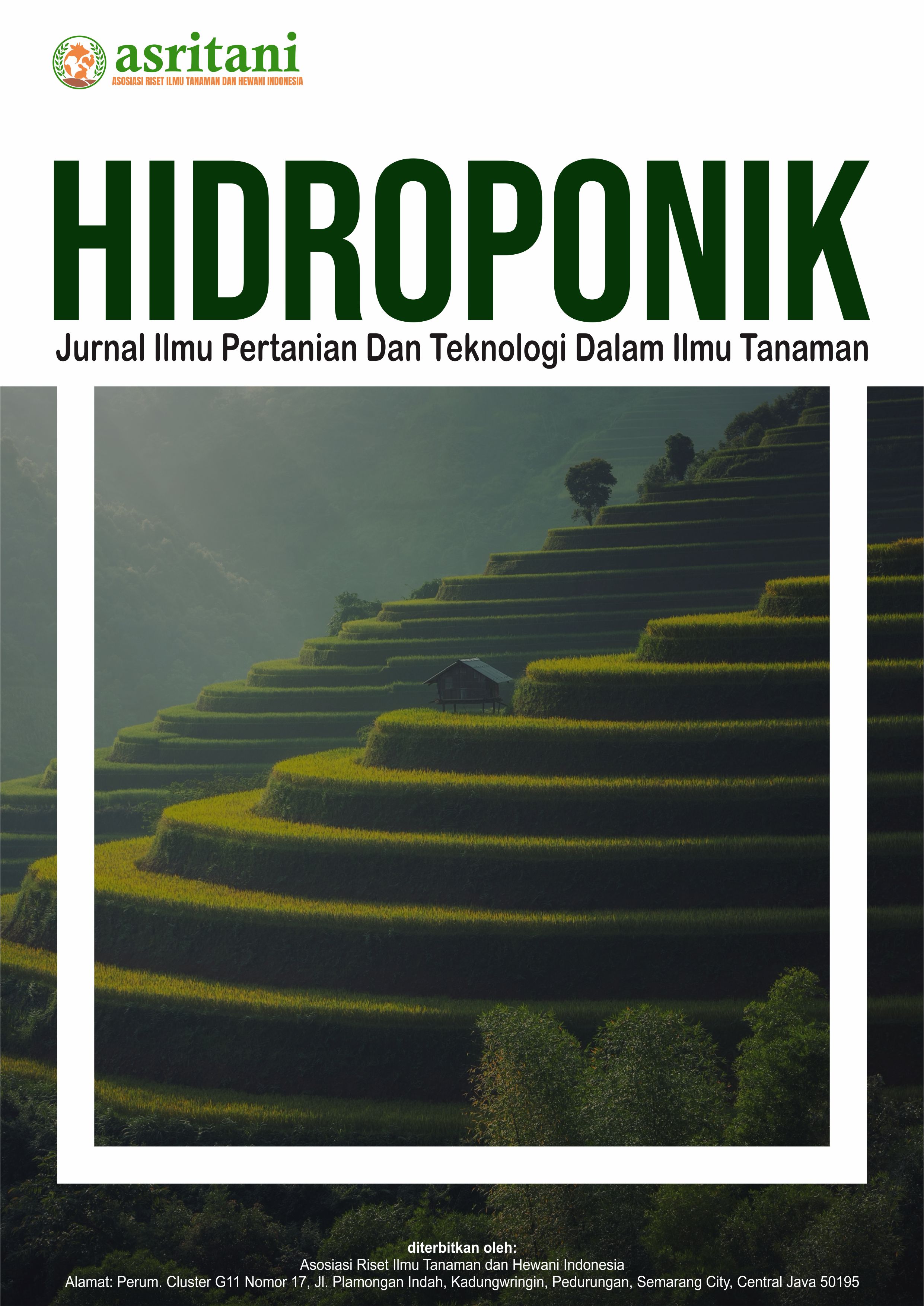Pengelolaan Sampah Organik Di Industri Galangan Kapal Dengan Metode Komposting Menggunakan Aktivator Ecoenzymes & Effective Microorganism 4 (EM4)
DOI:
https://doi.org/10.62951/hidroponik.v1i2.36Keywords:
composting, organik waste, ecoenzymes, shipyard industry,Effective Microorganism (EM4)Abstract
The shipbuilding industry produces organic and inorganic waste. The organic waste produced by the shipbuilding industry is dry leaves, dry grass, dry wood and other dry materials. Organic waste management is becoming increasingly important in this industry because the industry's very rapid growth has the potential to increase negative environmental impacts if not handled properly. Utilizing organic waste into fertilizer is an activity that can be carried out with the aim of reducing waste around the shipyard industrial environment. This organic fertilizer is made using a simple composting method so that it can be applied in this industry. The composting process involves 2 different treatments, namely the first is an activator solution in the form of a mixture of ecoenzymes, water and sugar solution and the second is using Effective Microorganism 4 (EM 4). The results of the research showed that these two treatments produced a pH that was not much different, namely 6.9 for EM4 and a pH of 7 for the ecoenzymes activator. The temperature of the compost produced in the ecoenzymes mixture treatment was 300C and in the EM4 treatment was 300C. This shows that the activity of decomposing microorganisms is running well.
References
Badan Standardisasi Nasional. (2004). Spesifikasi kompos dari sampah organik domestik. Badan Standardisasi Nasional, 12.
Ermavitalini, D., Jadid, N., Muslihatin, W., Saputro, T. B., Shovitri, M., Prasetyo, E. N., Sa’adah, N. N., & Purwani, K. I. (2019). Pelatihan Komposting Sampah Skala Rumah Tangga Dalam Pengelolaan Sampah Berbasis Masyarakat Desa Ketegan Tanggulangin Sidoarjo. Jurnal ABDI, 5(1), 39. https://doi.org/10.26740/ja.v5n1.p39-43
Hastuti, S., Martini, T., Purnawan, C., Masykur, A., & Wibowo, A. H. (2021). Pembuatan Kompos Sampah Dapur dan Taman dengan Bantuan Aktivator EM4. Proceeding of Chemistry Conferences, 6, 18. https://doi.org/10.20961/pcc.6.0.55084.18-21
Khusna, A. M., Karimah, J., & Ramdany, K. (2022). SEBAGAI BAHAN UTAMA PEMBUATAN ECOENZYMESE. 3(2), 139–143.
Putri F. Lamato, dkk. (2023). Analisis Aplikasi Eco-Enzyme Terhadap Biochemical Oxygen Demand Dan Chemical Oxygen Demand Pada Limbah Cair Tahu. Analisis Aplikasi Eco-Enzyme Terhadap Biochemical Oxygen Demand Dan Chemical Oxygen Demand Pada Limbah Cair Tahu Di Industri Tahu Malalayang, 21(85).
Sandi. (2021). Sistem Kendali Dan Monitoring Kelembapan, Suhu, dan pH Pada Proses Dekomposisi Pupuk Kompos Dengan Kendali Logika Fuzzy. Telekontran : Jurnal Ilmiah Telekomunikasi, Kendali Dan Elektronika Terapan, 8(2), 154–164. https://doi.org/10.34010/telekontran.v8i2.4710
Santosa, S., Hassan, M. S., & Kasim, A. H. (2023). Quality of an ecoenzymes e and potential of its residues as composting bioactivator. Jurnal Pengelolaan Sumberdaya Alam Dan Lingkungan, 13(3), 417–424. https://doi.org/10.29244/jpsl.13.3.417-424
Sari, I. P., Ilasabilirrosyad, A., Tanjov, Y. E., & Rahayu, S. M. (2023). Occupational Health and Safety Risks in the Shipbuilding Industry, Case Study at PT Blambangan Bahari Shipyard. Buletin Jalanidhitah Sarva Jivitam, 5(1), 45. https://doi.org/10.15578/bjsj.v5i1.12226
Selan, R. N., Pell, Y. M., Riwu, D. B. N., & Jasron, J. U. (2024). Pelatihan pembuatan pupuk kompos berbasis ecoenzymese. 8, 876–883.
Sugiatun. (2017). Tingkat Penggunaan Effective Mikroorganisms - 4 (EM4) Terhadap Kandungan Protein Kasar dan Serat Kasar Sabut Sawit Fermentasi. Jurnal ISTEK, 10(1), 139–153.
Suryanto, E. (2019). Pengaruh Aplikasi Dosis EM4 (Effective Microorganism 4) terhadap Rasio C/N dan Tekstur Kompos dari Kotoran Kambing sebagai Sumber Belajar Biologi SMP. Jurnal Lentera Pendidikan Pusat Penelitian LPPM UM METRO, 4(1), 53–62.
Wulandari, F. E. (2021). Tekhnik Pengomposan. In Tekhnik Pengomposan. https://doi.org/10.21070/2019/978-602-5914-66-9
Yasin, S. M., Kasim, N. N., Sapareng, S., & Jabal, J. (2019). Pengaruh Bioaktivator Dalam Proses Pengomposan Jerami Padi. Journal TABARO Agriculture Science, 3(1), 287. https://doi.org/10.35914/tabaro.v3i1.198
Yulia, R., & Al‘Amani, M. (2023). Pengaruh Bioaktivator Dan Lama Fermentasi Terhadap Kadar Karbon Dan Rasio C/N Dari Kompos Kulit Biji Coklat. PERISAI: Jurnal Pendidikan Dan Riset Ilmu Sains, 2(2), 257–263. https://doi.org/10.32672/perisai.v2i2.281
Yulianthi, P. E. (2022). DAUR ULANG SAMPAH ORGANIK MENJADI KOMPOS. https://dlh.bulelengkab.go.id/informasi/detail/artikel/10_daur-ulang-sampah-organik-menjadi-kompos
Downloads
Published
How to Cite
Issue
Section
License
Copyright (c) 2024 Hidroponik : Jurnal Ilmu Pertanian Dan Teknologi Dalam Ilmu Tanaman

This work is licensed under a Creative Commons Attribution-ShareAlike 4.0 International License.





